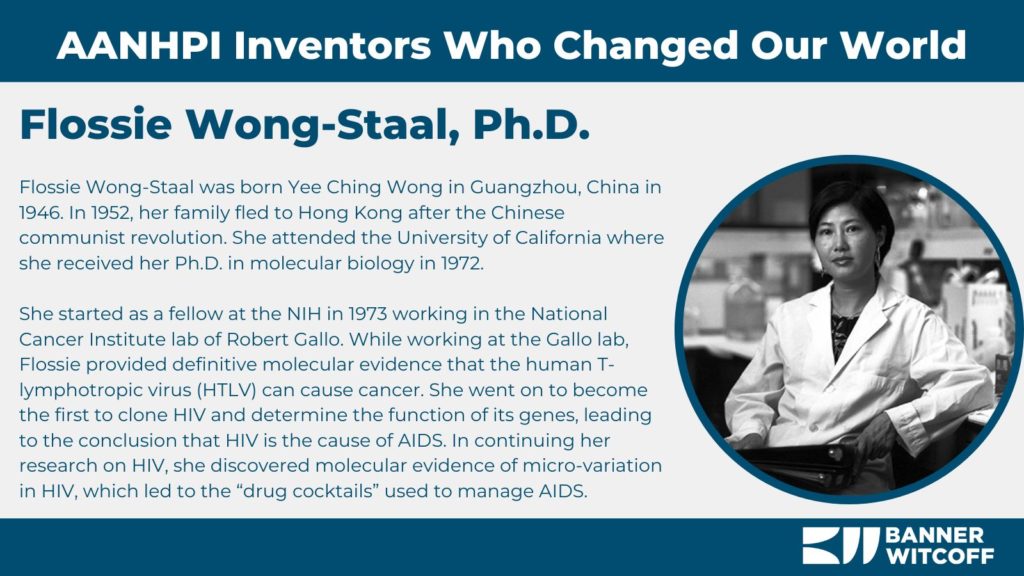Banner Witcoff recognizes Asian American, Native Hawaiian, and Pacific Islander Heritage Month by celebrating the stories and inventions of four notable AANHPI inventors who changed our world.
Peter Tsai, Ph.D. – Inventor of the N95 respirator
Peter Tsai, Ph.D. came to the United States from Taiwan in 1981 to study at Kansas State University where he earned a doctorate in materials science after completing over 500 credits in a variety of subjects such as engineering and sciences.
Eventually, Tsai become a professor at the University of Tennessee, Knoxville. There, he led a research team to develop a material that filtered air by attracting particles through electrostatically-charged fibers. In 1992, the team created a material that consisted of both positive and negative charges, attracting particles – such as dust, bacteria, and viruses – and trapping 95 percent of them by polarization before they can pass through the material. Despite the original intent of the material being for home air filters, the N95 mask was soon developed for construction workers who may be exposed to microparticles.
In 1996, the U.S. Centers for Disease Control realized the N95 mask could both attract and block viruses. When Tsai’s material was paired with 3M’s medical mask design, it became a mask used by medical professionals around the world.
You can read more about Peter Tsai, Ph.D., in this 2020 article from the U.S. Embassy in Georgia.

Flossie Wong-Staal, Ph.D. – The first to clone HIV, leading researchers to identify the virus as the cause of AIDS
Flossie Wong-Staal was born Yee Ching Wong in Guangzhou, China in 1946. In 1952, her family fled to Hong Kong after the Chinese communist revolution. While attending Catholic school, she was asked to pick an English name. Wanting a distinctive name, she chose Flossie at her father’s suggestion. Flossie later attended the University of California where she graduated cum laude in only three years and immediately received her Ph.D. in molecular biology.
She started as a fellow at the NIH in 1973 working in the National Cancer Institute lab of Robert Gallo. While working at the Gallo lab, Flossie provided definitive molecular evidence that human T-lymphotropic virus (HTLV) can cause cancer. She went on to become the first to clone HIV and determine the function of its genes, leading to the conclusion that HIV as the cause of AIDS. In continuing her research on HIV, she discovered molecular evidence of micro-variation in HIV, which led to the “drug cocktails” used to manage AIDS.
Flossie was the most-cited female scientist of the 1980s, with nearly 7,800 citations.
You can read more about Flossie Wong-Staal, Ph.D., by clicking here.

Ajay Bhatt – Creator of USB technology
Before the invention of USB technology, computers were littered with ports and plugs that left many users frustrated as they untangled wires and plugged and unplugged to reboot their machines. Ajay Bhatt was one of those users.
Taking inspiration from the common electrical wall outlet, Bhatt decided to develop a connection interface that would recognize and run new devices automatically when they were plugged into a computer. This device became the Universal Serial Bus (USB), which greatly simplified the plug and port designs on computers.
Ajay was born in Vadodara, Gujarat and graduated from the Maharaja Sayajirao University of Baroda, India. After moving to the U.S., he went on to receive his master’s degree from The City University of New York. He holds more than 132 U.S. and international patents, and was a winner of the European Inventor Award, presented by the European Patent Office, in 2013.
You can read more about Ajay Bhatt by clicking here.

Steven Shih Chen – Co-Founder of YouTube
Steven Shih Chen was born in Taiwan in 1978 and came to the United States at age 8. He studied computer science at the University of Illinois at Urbana-Champaign.
After graduation, Chen worked at PayPal, where he met Chad Hurley and Jawed Karim.
In 2005, the trio founded YouTube, a website designed to simplify video sharing online, after growing frustrated with the inefficiencies of sharing video content on existing platforms. In just a year, the video-sharing platform was the 10th most popular website. Today, YouTube is one of the most popular online video distribution platforms with more than 4 billion hours of video viewers monthly, and an estimated 500 hours of video content uploaded every minute.
You can read more about Steven Shih Chen by clicking here.


